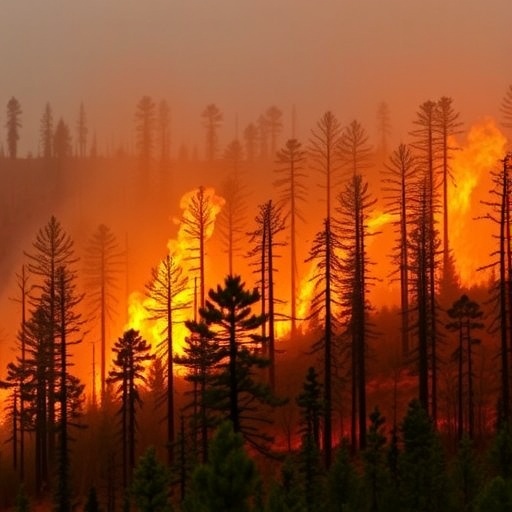Prescribed burns are a critical tool in modern wildfire management, often described as “fighting fire with fire.” These controlled fires are intentionally ignited in specific areas to consume excess vegetation that could otherwise serve as fuel for more destructive wildfires. Often framed as a beneficial ecological intervention, prescribed burns aim to reduce the severity of future fires, promote healthier forest ecosystems, and protect human communities from catastrophic fire events. However, despite their advantages, prescribed burns also produce smoke containing harmful pollutants that can negatively impact respiratory health and environmental quality.
All types of fires, whether natural wildfires or prescribed burns, generate smoke laden with a complex mixture of gases and fine particulate matter. Among these pollutants are polycyclic aromatic hydrocarbons (PAHs), a group of organic compounds formed during incomplete combustion of organic material. PAHs are especially concerning because many of them are classified as carcinogenic substances capable of causing cancer, lung tissue damage, and immune system suppression when inhaled. These health risks elevate the importance of minimizing toxic emissions from controlled fires, particularly in areas with nearby populations vulnerable to air pollution.
In a pioneering study recently published in Atmospheric Pollution Research, researchers at Stanford University have proposed methods to substantially reduce the health hazards associated with prescribed burns by carefully controlling fire conditions. Their groundbreaking research indicates that by optimizing factors such as moisture content, heat output, and oxygen availability during burns, it is possible to lower PAH emissions by as much as 77%. This reduction in pollutant output translates directly into a potential halving of cancer risk posed by smoke exposure, a remarkable advancement in prescribed burn safety.
Karl Töpperwien, the lead author and postdoctoral researcher in Stanford’s Department of Mechanical Engineering, stresses the dual benefit of this approach. “We can essentially kill two birds with one stone – protect ecosystems while simultaneously protecting communities that would be otherwise at risk,” he explains. This dual focus underscores the balancing act fire managers must achieve: maintaining the ecological benefits of fire while mitigating its immediate human health impacts.
To realize these insights, the research team employed an interdisciplinary strategy, collaborating across fields that span mechanical engineering, medical science, physics, and environmental chemistry. This partnership included medical scientists from Harvard’s T.H. Chan School of Public Health, physicists from the SLAC National Accelerator Laboratory, and chemical experts at Aerodyne Research Inc. Such cross-institutional cooperation allowed the team to leverage diverse expertise in toxicology, precision measurement technologies, and combustion science, a fusion essential to tackling the complex challenge of smoke emissions.
Identifying the key harmful pollutants was the first step. The medical team at Harvard focused on polycyclic aromatic hydrocarbons recognized as high-priority carcinogens in wildfire smoke. Many PAHs are on the EPA’s list of carcinogenic pollutants due to their deleterious long-term effects on human health, including inflammation and various chronic diseases. Concentrating on PAHs offered a direct link between pollutant generation and specific health outcomes, guiding the study’s focus toward meaningful exposure mitigation.
Measuring these hazardous substances with precision posed a significant challenge. The chemists involved brought advanced expertise in experimental methodologies to accurately quantify PAHs and aerosol particles with high selectivity in real time. Their efforts were aided by the construction of a specialized combustion chamber at Stanford, where controlled burns of Eastern White Pine—chosen as a representative wood species with high PAH emission profiles—were conducted. This sophisticated apparatus allowed nuanced manipulation of fire parameters and precise monitoring of resultant emissions.
Focusing on the fire’s physical conditions, the team tested how moisture content, heat intensity, and oxygen levels influenced the formation of PAHs. Their experiments revealed complex chemical dynamics: wood moisture between 20% and 30% optimized combustion, minimizing PAH production. Too dry, the fire burns rapidly and produces more smoke; too wet, it smolders inefficiently, increasing toxic emissions. Similarly, maintaining heat intensity between 60 and 70 kW/m² was identified as the optimal range to drive chemical reactions away from PAH formation pathways. Oxygen concentration also had to be finely tuned, kept within 5% to 15% to prevent inefficient combustion or runaway fires.
These findings challenge conventional prescribed burn practices and highlight previously underappreciated levers to improve smoke quality. By dialing in these parameters, prescribed burns could become significantly cleaner and safer, protecting not only forest ecosystems but also respiratory health in surrounding communities. The implications extend to environmental justice, as smoke from wildfires often disproportionately affects vulnerable populations.
Translating laboratory results into field-scale prescribed burn operations presents a complex set of challenges, but the researchers remain optimistic. Many of the techniques to control moisture and fire conditions are already in use at varying scales. For instance, forest managers routinely measure and adjust wood moisture through pre-burn treatments such as drying and chopping. Oxygen levels and heat intensity, influenced by fire pile arrangement and wood size, require further refinement to achieve the precision seen in lab tests.
The team plans to conduct in situ field trials to validate the lab findings under real-world conditions. Expanding their research to include various wood species and balancing factors such as fuel consumption efficiency and cost will further enhance the practical utility of this approach. This continued work aims to develop generalizable guidelines that can be adopted by fire management agencies worldwide to optimize prescribed burn protocols.
Finally, the researchers acknowledge the complexity of fire behavior extends beyond emission reduction. According to senior author Matthias Ihme, “It’s not only finding where the flame is, but also how the smoke is transported, how it affects long-term health, and how it is admitted into the environment as it settles from the air onto the soil.” Understanding the full lifecycle and impacts of wildfire smoke remains a priority, encompassing atmospheric chemistry, environmental deposition, and public health domains.
This study represents a significant stride forward in making prescribed burns more environmentally and socially sustainable. It exemplifies how multidisciplinary collaboration can unravel complex issues and produce actionable solutions that benefit ecosystems and human health alike. As wildfires become more frequent and intense due to climate change, innovations like these offer a valuable pathway to mitigate their damaging effects while harnessing the ecological necessities of fire.
Subject of Research: Reducing health risks of prescribed burns through optimization of fire conditions to minimize harmful PAH emissions.
Article Title: Laboratory Optimization of Prescribed Fire Parameters Slashes Toxic Smoke Emissions by 77%.
News Publication Date: February 10, 2025
Web References:
https://www.sciencedirect.com/science/article/abs/pii/S1309104225000406
https://profiles.stanford.edu/karl-toepperwien
https://engineering.stanford.edu/
https://hsph.harvard.edu/
https://www6.slac.stanford.edu/
https://aerodyne.com/
https://sustainability-accelerator.stanford.edu/focus-areas/climate-adaptation
https://sustainability-accelerator.stanford.edu/how-we-work/accelerator-approach
References:
Töpperwien K., Ihme M., et al. (2025). [Full citation from Atmospheric Pollution Research pending DOI finalization]
Keywords: Forest fires, Pollution control, Smoke, Air pollution, Environmental health
Tags: community protection from wildfiresecological benefits of controlled burnsenvironmental impact of prescribed fireshealth risks of smoke from controlled burnsimproving forest fire management practicesmethods to reduce smoke emissionsminimizing toxic pollutants from prescribed firespolycyclic aromatic hydrocarbons in fire smokeprescribed burn safety measuresrespiratory health and air qualityStanford University wildfire researchwildfire management strategies





